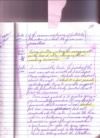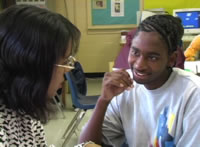Context
Where do I teach?
Teaching Practice
What's my approach?
Student Work
Resources
Standards
Archive
Faculty Lounge
|
Culturally Engaged Instruction: Inquiry & Practice

Early in my teaching career, I became a teacher-researcher. That decision totally altered my classroom and professional career. Every professional teacher should be reflective about his/her work as stated in the Core Propositions of the National Board for Professional Teaching Standards: “Striving to strengthen their teaching, accomplished teachers critically examine their practice, seek to expand their repertoire, deepen their knowledge, sharpen their judgment, and adapt their teaching to new findings, ideas, and theories.”
Teacher researchers take this self-examination to the next level by actually engaging in systematic study of their own teaching, often using many of the same qualitative or quantitative methods employed by our colleagues at the university levels. I have kept teaching journals, collected audio and video tapes of my teaching, constructed surveys, conducted student and parent interviews, collected assessment data of various types, and otherwise carefully documented the teaching and learning in my classroom. While not every teacher should or can be this exhaustive, taking what’s known as an inquiry stance towards one’s teaching can enrich not only the individual teacher, but the entire profession.
Follow the links below to read more about my inquiry into CEI. See My Approach to Teaching Grammar and My Approach to Writers' Workshop for more about classroom practices that are based on the theories I've developed.
|
| Circles of Influence: My Research Journey Into Culturally Engaged Instruction |
|
In this paper, I chronicle how my struggle with teaching Standard English in the Mississippi Delta becomes the impetus to develop “culturally engaged instruction” for African American students.
Related Link: Going Public with Our Teaching |
| Between a Rock and a Hard Place: African Americans and Standard English |
|
WARNING: It is extremely hazardous to attempt the use of any teaching method or technique without careful consideration of the theory(ies) upon which that practice is based.
Between a Rock and a Hard Place is the product of my initial research into the issues surrounding the teaching of standard English to African American students. What I learned from the review of literature and from my own classroom investigations inform everything else I do in my teaching. Although my focus was on Black students, many of the findings apply across cultural lines.
My research began when I realized that my students were uncharacteristically resistant to learning how to use standard American English (SAE). I started by looking at the professional literature on teaching of grammar. Not only was there very little of practical value written (and it was contradictory), but too much of the professional debate seemed to stall on how Black dialect speakers could overcome their cultural deficits to become proficient in standard English.
The deeper and more important questions, however, are not how do we teach SAE to African American students, but why, and will that knowledge, as well as our methods, genuinely empower the students and their communities? Language arts instruction with Black students must take into account the specific historical and cultural features of language use and abuse within and upon the larger African American community. The great ambivalence within the Black community towards SAE is a historically created phenomenon that began with the ravishing of our original languages and customs. The ongoing debates and near hysteria over “Black English” and “Ebonics” are symptoms of this deeply complicated relationship. We are not held in low esteem because of our language; our language is held in low esteem because it is ours. Even after the momentous work and debate among English/language arts professionals over the past 20-25 years, too many Black students and their teachers find the language arts classroom to be a battleground, rather than a secure learning environment.
Failing or refusing to take historical, cultural, and political contexts into account, some educators persist in trying to “fix” what they perceive as defects in Black students and their language skills. Culturally effective language arts instruction depends upon a teacher’s ability and willingness to learn and respect the literacy accomplishments, needs, and potential of specific students. The success or failure of particular teaching methods has more to do with this type of respectful knowledge than with any particular pedagogical recipe. The question is not whether Black students can master SAE, but whether they will be offered the opportunity to do so on culturally acceptable terms. |
Culturally Engaged Instruction: A Definition |
|
Empowering language arts instruction is a dynamic practice shaped by informed and collaborative analysis of the particular cultural experiences, strengths,and learning goals of a specific group of students within a particular community.
Components of Culturally Engaged Instruction
1. Dynamic practice - teaching that changes in relation to the other six components
2. Informed and collaborative analysis - the many sources of information (pedagogical knowledge) that accomplished teachers draw upon in the classroom and how those sources are analyzed and synthesized not by the teacher alone, but with significant input from other stakeholders (students, parents, community, what I call the circles of influence).
3. Particular cultural experiences - the cultural background of the students (including social and political history of which they may not be consciously aware), the teacher's own cultural experiences, the culture of that particular school, the culture that develops within the classroom
4. Particular strengths - how a teacher comes to know what these students as individual learners already know and can do well; how do I use that to guide instruction
5. Particular learning goals - expectations of the state and district, teacher expectations, the students' own expectations, those of their parents and community
6. A specific group of students - how the "group chemistry" affects the culture of the classroom and, through that, the process of teaching and learning for this teacher and these students
7. A particular community - how characteristics and norms within and outside the classroom affect teaching and learning |
My Teaching Journal
|
 |
Notes from My Teaching Journal, 9/9/97 - 2/21/01
I have kept a teaching journal from the time I started student teaching. Here are some excerpts from my journals that are particularly related to my research and some of the discoveries and struggles related to it. See the full set of notes in pdf form or read a sample excerpt.
|
TeachersCount Interview on Culturally Engaged Instruction
|
 |
Read an interview with me by TeachersCount about my research and more. |
|
Site last updated
June 23, 2006
|
 Culturally Engaged Instruction:
Culturally Engaged Instruction: 
